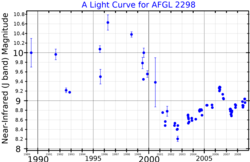
Summary
AFGL 2298, also known as IRAS 18576+0341, is a luminous blue variable star (LBV) located in the constellation Aquila, very close to the galactic plane. Its distance is not well known; it may be anywhere between 23,000 and 42,000 light years (7,000 to 13,000 parsecs) away from the Earth.[4] Despite being extremely luminous, it is extremely reddened by interstellar extinction, so its apparent magnitude is brighter for longer-wavelength passbands; in fact, in visual wavelengths it is completely undetectable.[7]
| Observation data Epoch J2000 Equinox J2000 | |
|---|---|
| Constellation | Aquila |
| Right ascension | 19h 00m 10.89s[2] |
| Declination | +03° 45′ 47.1″[2] |
| Characteristics | |
| Spectral type | B8I,[3] B:I:[e],[4] B0-0.5I[5] |
| Apparent magnitude (J) | 12.164[2] |
| Apparent magnitude (H) | 8.918[2] |
| Apparent magnitude (K) | 6.91[6] |
| Variable type | LBV[4] |
| Astrometry | |
| Distance | 30,000±10,000 ly (10,000±3,000[4] pc) |
| Absolute bolometric magnitude (Mbol) | −11.25[1] |
| Details | |
| Radius | 158 - 385[1] R☉ |
| Luminosity | 1,300,000 - 2,000,000[1] L☉ |
| Temperature | 11,000 - 15,500[1] or 26,000[5] K |
| Other designations | |
| Database references | |
| SIMBAD | data |
AFGL 2298 has an absolute bolometric magnitude of −11.25,[1] making it one of the most luminous stars known. Indeed, many of the hottest and most luminous stars known are luminous blue variables and other early-type stars. However, like all LBVs, AFGL 2298 is highly variable and the bolometric magnitude refers to its peak luminosity.[1] Its status as an LBV was confirmed in 2003.[4]
Like most extremely massive stars, AFGL 2298 is undergoing mass loss.[5] For example, in 2005 it was estimated to be losing 3.7×10−5 solar masses each year,[5] although the rate of mass loss itself varies frequently and dramatically.[1] The stellar mass is currently being ejected as a nebula around the star (similar to AG Carinae), which was imaged by the Very Large Telescope in 2010.[8] The nebula was found to be fairly circular, and the properties of the dust appeared to be constant throughout the entire nebula.[8]
| Effective temperature (K) | Mass loss rate (M☉/yr) | Bolometric luminosity (L☉) | |
|---|---|---|---|
| June 2001 | 11,700 | 4.5×10−5 | 1.5×106 |
| August 2002 | 10,900 | 1.2×10−4 | 1.3×106 |
| June 2006 | 10,300 | 5.2×10−5 | 2.0×106 |
| May 2007 | 10,900 | 4×10−5 | 1.5×106 |
See also edit
References edit
- ^ a b c d e f g h i Clark, J. S.; et al. (2009). "Bolometric luminosity variations in the luminous blue variable AFGL2298". Astronomy and Astrophysics. 507 (3): 1555–1565. arXiv:0909.4160. Bibcode:2009A&A...507.1555C. doi:10.1051/0004-6361/200912358. S2CID 119187994.
- ^ a b c d Cutri, Roc M.; Skrutskie, Michael F.; Van Dyk, Schuyler D.; Beichman, Charles A.; Carpenter, John M.; Chester, Thomas; Cambresy, Laurent; Evans, Tracey E.; Fowler, John W.; Gizis, John E.; Howard, Elizabeth V.; Huchra, John P.; Jarrett, Thomas H.; Kopan, Eugene L.; Kirkpatrick, J. Davy; Light, Robert M.; Marsh, Kenneth A.; McCallon, Howard L.; Schneider, Stephen E.; Stiening, Rae; Sykes, Matthew J.; Weinberg, Martin D.; Wheaton, William A.; Wheelock, Sherry L.; Zacarias, N. (2003). "VizieR Online Data Catalog: 2MASS All-Sky Catalog of Point Sources (Cutri+ 2003)". CDS/ADC Collection of Electronic Catalogues. 2246: II/246. Bibcode:2003yCat.2246....0C.
- ^ Ramírez Alegría, S.; Herrero, A.; Rübke, K.; Marín-Franch, A.; García, M.; Borissova, J. (2018). "Identifying two groups of massive stars aligned in the l 38° Galactic direction". Astronomy and Astrophysics. 614: A116. arXiv:1801.08683. Bibcode:2018A&A...614A.116R. doi:10.1051/0004-6361/201731720. S2CID 119427413.
- ^ a b c d e Clark, J. S.; et al. (2003). "Confirmation of the Luminous Blue Variable nature of AFGL 2298". Astronomy and Astrophysics. 403 (2): 653–658. Bibcode:2003A&A...403..653C. doi:10.1051/0004-6361:20030389.
- ^ a b c d Umana, G.; Buemi, C. S.; Trigilio, C.; Leto, P. (2005). "Current day mass loss rate for Luminous Blue Variable IRAS 18576+0341". Astronomy and Astrophysics. 437 (1): L1–L5. Bibcode:2005A&A...437L...1U. doi:10.1051/0004-6361:200500126.
- ^ Kazarovets, E. V. (2006). "The 78th Name-List of Variable Stars". Information Bulletin on Variable Stars. 5721: 1. Bibcode:2006IBVS.5721....1K.
- ^ a b "AFGL 2298". SIMBAD. Centre de données astronomiques de Strasbourg. Retrieved 26 January 2017.
- ^ a b Buemi, C. S.; et al. (2010). "VISIR/VLT and VLA Joint Imaging Analysis of the Circumstellar Nebula Around IRAS 18576+0341". The Astrophysical Journal. 721 (2): 1404–1411. arXiv:1008.0997. Bibcode:2010ApJ...721.1404B. doi:10.1088/0004-637X/721/2/1404. S2CID 119281049.



